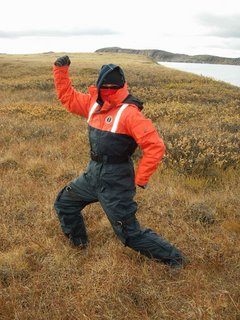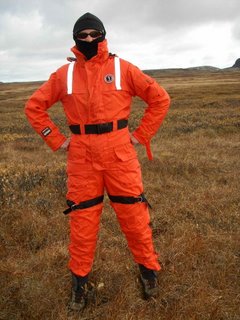 The epic saga of the backpack electrofisher
The epic saga of the backpack electrofisherContext: Backpack electrofishers are devices that run electrical current through the water and stun fishes (or mysids, as the case may be – see previous entry). Kathryn thinks that they were invented for torture during the Spanish Inquisition. The torture part doesn’t come through electrocution, but through carrying the danged thing. In fact, Kathryn can’t carry it because the (external) backpack frame is so long that when the waist strap is pulled tight her legs are cinched together. It’s much more comfortable, however, than the model I became accustomed to in the late ‘90’s, that has a generator instead of a battery pack.
Day 1: Heidi and Kathryn inventory the gear and find two backpack electrofishers (BPEFs). One is set aside for the Fish Dudes, and we lay a claim on the second. All appears well, although we are missing one cable for a charger.
Day 20: We develop the mysid sampling technique. Unfortunately, this requires Kathryn to be completely stooped over to scoop small mysids and her back turns into large knots. I must keep the shocker vertical enough that the safety device doesn’t trip (if you fall in, you can’t electrocute yourself, supposedly) while stooping over enough to scoop mysids. I report a serious searing pain in my shoulder blade (“It’s fine, I’m sure it’s fine”), upon which time we start planning our trip to the spa. Also at this time, Fish Dudes report a serious malfunction in their BPEF and request to share ours. This presents difficulties as we are staying out at the Doris weatherhaven. Much bartering occurs and one sheep is traded between two shepherds, each of which needs his respective wool. A second sheep is requested, but due to shipping costs the request is denied.
Day 40: Fish Dudes depart and we take over sole custody of BPEF 2 (so says the Golder label), and take it with us out to Doris weatherhaven. Unfortunately, two small electrical pins break off in a coupler, leaving the battery with small shards of broken pins (“It’s fine, I’m sure it’s fine”). These batteries, another device from the Spanish Inquisition, are large, very heavy, duct-taped covered cubes that Kathryn’s fingers cannot even stretch across. We have a solar panel for power in the weather haven, which charges a 12-V battery pack that we then use to charge other batteries. Unfortunately again, it turns out that the duct tape conceals 2 12-V batteries – not the one big one we thought – and, (you guessed it, unfortunately), we turn our Canadian Tire Eliminator power pack into a Canadian Tire Eliminated power pack. At this point, we would also like to note that we have been weathered in for a day, and have just enough satellite phone battery left to request a second radio battery from camp (since we just eliminated the eliminator).
Day 41: Sun arrives, and our eliminated power pack rises from the ashes. I call Golder and they agree to send up new pins with detailed instructions.
Day 48: Heidi is crouching over BPEF in middle of tundra attempting to decipher instructions. She and Kathryn remove the bent pins and reinsert new ones using a Leatherman (the wire strippers and soldering iron being kilometres away in camp). All appears to be going well until Heidi muses, “I think polarity matters on this here coupler. What do you reckon 3 black wires and one yellow one mean in terms of positive and negative? And how does that relate to numbers 1,2,3, and 4 on the other end of this coupler?”
Kathryn: “One electrocuted sheep. Burnt wool everywhere.”
Heidi: “That’s what I thought.”
Heidi calls Golder and, from their control tower in the Edmonton warehouse, they take apart a second shocker, in an attempt to provide guidance.
Golder fix-it dude: “Okay, you should have a red, a black, a green, and a yellow wire.”
Heidi: “I have three blacks and a yellow.”
Fix it dude: “Uh-oh.”
Heidi: “That’s what I said.”
We abandon the repair job for the day while Golder fix-it dude completely takes apart the innards of another shocker. Heidi calmly evaluates how it may have been cheaper to ship up a second, working sheep, but chooses not to dwell over lost wool.
Day 49: Golder fix it dude recommends that Heidi use a test meter (when next in camp) to determine the two pairs of common wires. She then has a 50/50 chance of frying the shocker or fixing it.
“Are you sure about this?”
“Well, we’ll probably toast the thing down here, so you might as well toast it up there and be done with it. Just don’t kill yourself while you’re at it.”
Day 50: Heidi requests flight into camp to drop off some samples, etc. Upon bribing the electrician with charr, we think we have determined the polarity of the wires.
“Okay, you ready?”
“Yeah, stand back.”
Power switch is flicked.
Burnt sheep. Battery harness melted. Surprisingly, though, battery itself is not melted. NOTE: Duct tape conducts.
Electrician (totally dead pan while we try to make sure the smoke alarm does not go off) “Well, I guess we got the short end of that 50.”
“Yup, but we know which one is NOT positive.”
Heidi and the electrician reverse their earlier supposition of polarity, fire it up again, and start another smoulder. At which point they discover that there is a loose connection.
THE SHEEP IS HEALED.
Day 50: Heidi and Kathryn happily set off for Roberts Lake. They have seen the charr for 3 consecutive days, and now have a reasonable chance of catching them. The shocker works, and the charr are caught (YIPPEE – they send the bribe back to the electrician).
Day 53: After spending a night in main camp and charging the shocker battery, Heidi and Kathryn cheerfully set off for Roberts Lake with a newly-replenished supply of cookies. We arrive at Roberts Lake and pull our battery out of the cargo pod.
“MERF, MERF AHHHHHHHHHHHHHHHHH!” Heidi suddenly screams.
The coupler (on the battery end this time) is sitting, dejected and completely detached from the battery, at the bottom of the cargo pod, having ripped off during flight.
We have decided to sacrifice our last working mechanical pencil to the gods.
In other news, Spot the wolf ate my waterproof SealLine bag today.






